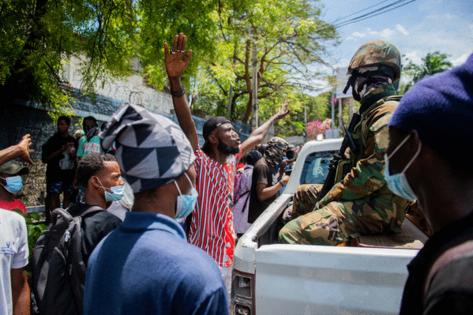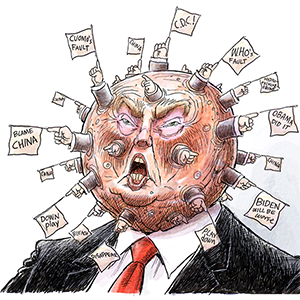Haiti gangs' expansion, human-rights violations, threaten whole Caribbean, UN warns
Published in News & Features
For days, the message circulated on WhatsApp chats, warning of an imminent attack.
The message, which claimed to be from Jeff Laros, the sanctioned leader of Haiti’s so-called Taliban gang, didn’t specify when or where. But residents of Lascahobas, an important trading point between Haiti and the Dominican Republic, stood their guard.
Shortly after dawn on July 3, a bloody surprise assault began.
Armed men on motorcycles and in vehicles from the gang based in Canaan, north of Port-au-Prince, stormed Desvarieux, Savane La Coupe and Sarrazin near Lascahobas. A Haitian police officer deployed to defend the mango and coffee growing region was killed, as were seven others.
“This was an area that never had any problems; it was always safe,” Lascahobas Mayor Fredener Joseph told the Miami Herald. “These guys carried out a lot of destruction, a lot of homes have been burned, destroyed.”
While the attack on Lascahobas may seem like just one more horrific blow in Haiti’s ongoing gang warfare, it has raised alarms in and outside the country because of what it signals about the evolving gang threat: Criminal armed groups are no longer just consolidating power in Port-au-Prince, but are rapidly expanding north—a point underscored Friday in a new United Nations report.
The report, which looks at the sharp rise in attacks, particularly in the Lower Artibonite and central regions, between October 2024 and June, warns that the expanding presence of armed groups outside of metropolitan Port-au-Prince threatens to destabilize not just Haiti, but the wider Caribbean region.
“The human rights violations and abuses that we have documented are further evidence of why Haiti and the international community urgently need to step up to end this violence,” U.N. Human Rights Spokesperson Ravina Shamdasani said from Geneva.
There were 4,864 killings between October and June, at least 1,018 of them in the rice-growing Artibonite region, the Central Plateau and the towns of Ganthier and Fonds Parisien, east of the capital. The mass killings coincide with attacks carried out by the powerful Viv Ansanm gang coalition and its allies, including the Taliban gang located in Canaan, and 400 Mawozo operating in the Ganthier area, as well as the Gran Grif gang based in the Artibonite.
Earlier this week, the U.N. Security Council announced that Gran Grif and Viv Ansanm had been added to its global sanctions list. The move followed a May decision by U.S. Secretary of State Marco Rubio to label the group as Foreign Terrorist Organizations and Specially Designated Global Terrorists.
The joint report was produced by the U.N. Integrated Office in Haiti and the U.N. High Commissioner for Human Rights. It notes that since last year there has been “a sharp increase in killings, kidnappings, sexual violence, and the destruction of property” in the affected localities.
“Human rights violations outside of Port-au-Prince are intensifying in parts of the country where the presence of the state is extremely limited,” said Ulrika Richardson, the U.N. Resident Coordinator in Haiti. “The international community must strengthen its support for the authorities.”
The report’s authors detail a number of recent attacks to highlight the growing strength of the gangs and their ability to deploy hundreds of armed members into an area, as well the ineffectiveness of the response led by the Haiti National Police with assistance from a Kenya-led support mission.
Though the report was written before last week’s attack on Lascahobas, about 12 miles from the Haitian border with the Dominican Republic, it sounds the alarm over the border’s strategic importance in the push by gangs to control key roads.
“The gangs appear to be pursuing a strategic objective of establishing a presence in localities along key roadways crossing” the center and Artibonite, the report said, “particularly with the aim of controlling routes that connect the capital to the northern regions and to the border with the Dominican Republic.
“This expansion of gang territorial control poses a major risk of spreading violence and increasing transnational trafficking in arms and people, which could lead to significant destabilization for countries in the Caribbean sub-region, especially given the extremely limited presence of public administration and United Nations entities in these” regions, the report stressed.
UN warnings date to 2023
U.N. officials warned as far back as the end of 2023 about the intensification of gang-related criminal activity and human rights abuses in the Lower Artibonite.
The violence was largely driven by the growing power of the Gran Grif and Kokorat San Ras gangs, which were supported by influential politicians and business people in the region. The gangs also received backing from other criminal groups operating in Port-au-Prince— particularly the gangs from Canaan, Grand Ravine and Village de Dieu. They provided the Artibonite gangs with weapons and manpower to help them seize control of National Road 1, connecting the capital to the north. The areas most affected were agricultural regions in the Lower Artibonite, including Gros-Morne, L’Estère, Petite Rivière de l’Artibonite, Saint-Marc and Verrettes.
In October, after at least 100 people in Pont Sondé were gunned down by members of the Gran Grif gang, security forces were deployed.
Even as gang members continued to launch “sometimes extremely violent attacks” in remote rural areas far away from the main roadways, the deployment of both Haitian police and Kenyan force led to an overall reduction in criminal gang activities in several communities of the Lower Artibonite region, the report said.
But by the end of March, things began to deteriorate. “A lack of logistical resources and personnel had prevented the security forces from regaining control or restoring public order,” the report added, particularly in neighboring Petite Rivière de l’Artibonite, allowing Gran Grif time to rearm and reorganize.
From 21 March on, the gang launched attacks against several areas in the communes of Petite Rivière de l’Artibonite and Marchand Dessalines. “During these attacks, the gangs targeted the population, firing indiscriminately at their homes and at individuals attempting to flee,” the report said.
By April, an attack in a locality known as Cité de la Crête à Pierrot had left at least 57 people dead, 36 hostages, over 80 houses burned down and more than 13,000 people forcibly displaced. During the assault, gang members surrounded a joint police base in Ségur. The base was permanently abandoned.
“Despite occasional interventions, the security forces remain unable to restore order on a lasting basis,” the report said, noting at least one Kenyan police officer was killed and another continues to be regarded as missing, though local media has said he was killed. In June, the total number of internally displaced persons in the Artibonite department had reached 92,304, representing a 9% increase compared to December.
Self-defense groups on the rise
The poor response of the security forces have given rise to so-called self-defense groups. They are seen by many Haitians as the only entities capable of ensuring security in their communities. But they too are committing abuses, killing not only individuals suspected of gang affiliation but also members of their families, the U.N. warns.
A major turning point in the cycle of violence between gangs and self-defense groups was the Pont Sondé massacre. After gangs targeted residents, members of a self-defense group went door-to-door killing people they accused of conspiring with gang members.
While Gran Griff was sowing terror in the Aribonite earlier this year and Viv Ansanm was taking over Port-au-Prince, tensions in the central region were worsening.
The area went from experiencing no gang attacks to having bullet-ridden bodies strewn in the streets of Mirebalais in late March, when members of the 400 Mawozo and Taliban gangs joined forces. At least 50 homes were set ablaze and more than 500 inmates. were freed from prison. At least 15 people were killed including, two nuns.
On the same day of the Mirebalais attack, the Canaan gang members attacked Saut-d’Eau, a town at the crossroads of the west region.
After a first assault was repelled, gang members tried again on April 3 with more than 600 men. Police and residents fled, the U.N. said. Two weeks later, the Canaan gang attacked La Chapelle in the Artibonite and set up a checkpoint before retreating to Saut-d’Eau.
In June, the U.N. said, more than 147,000 people fled their homes in the central region, once a bastion of safety for those trying to escape the horrors of the capital. The number represents a 118% increase compared to December.
Despite a few operations by the security forces, Mirebalais and Saut-d’Eau remain under gang control.
Fears of border conflict
Lascahobas mayor Joseph believes gangs are after two things in the area: control of the Peligre hydroelectric dam, and access to the Haiti-Dominican border.
“If the government doesn’t put its head together to push back the gangs they will head toward Belladère and then we will be at war, because the Dominicans will never accept this,” Joseph said of Haiti’s contentious neighbor, which has been beefing up patrols on its side of the border. “Belladère and Lascahobas are both border towns.”
The U.N. report notes that the Belladère border post, located 62 miles from the capital has for several years been a transit zone for trafficking in arms, drugs and other contraband coming from or heading to the Dominican Republic.
As a result, controlling the roads crossing the center region is strategically important for the gangs and their supporters in trafficking networks.
William O’Neill, the U.N.’s independent human rights expert who raised concerns about the border after a recent visit to Haiti, said gangs that gain access to the important trading route leading to the Dominican Republic border could see their income rise.
“They could extort lots of money from vehicles and people moving through,” he said.
Joseph said the attack has left entire areas deserted as residents flee into the woods or into shelter. He said there seven elderly [epple ajd 20 others who are disabled died in the aftermath.
“We need the international community to hurry up and come give us a hand, because the force that we have here, they can’t do the job,” he said. “They need to send the U.N.”
©2025 Miami Herald. Visit at miamiherald.com. Distributed by Tribune Content Agency, LLC.







Comments